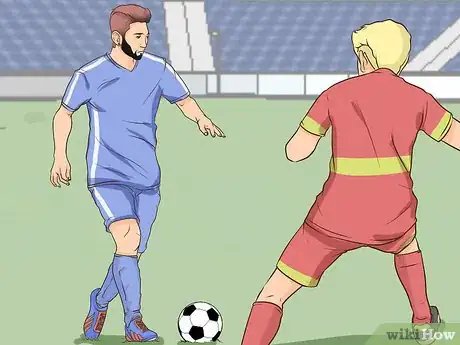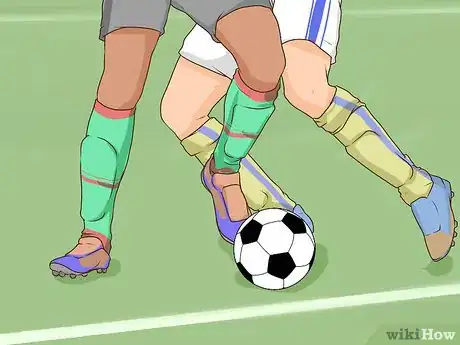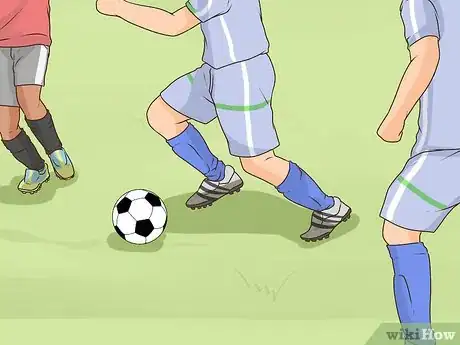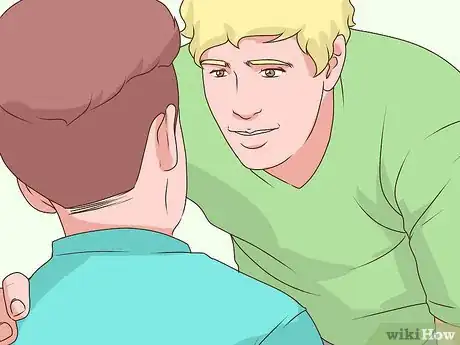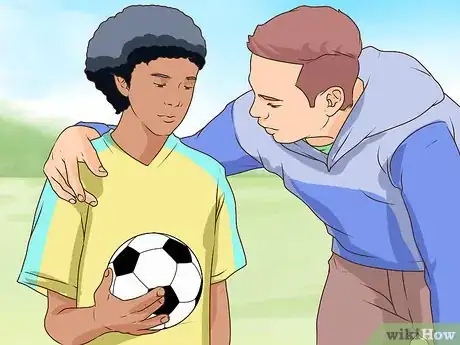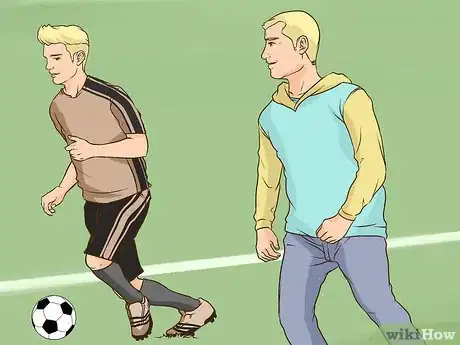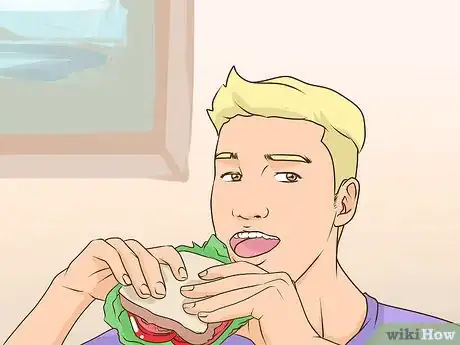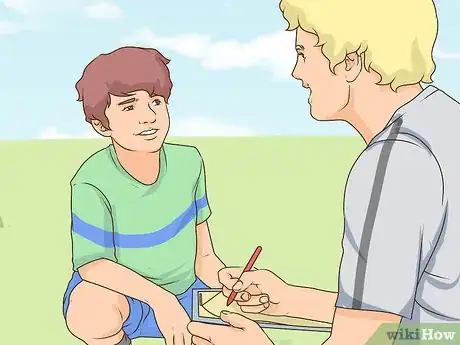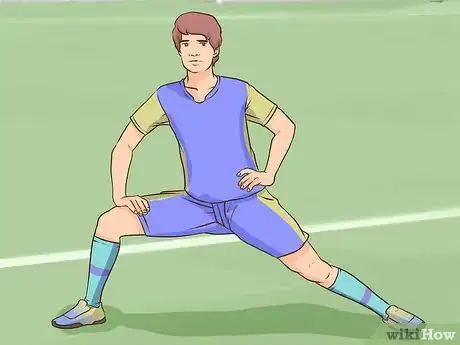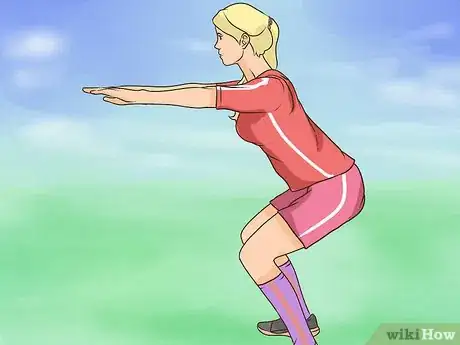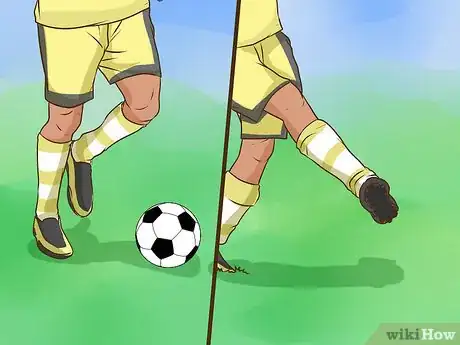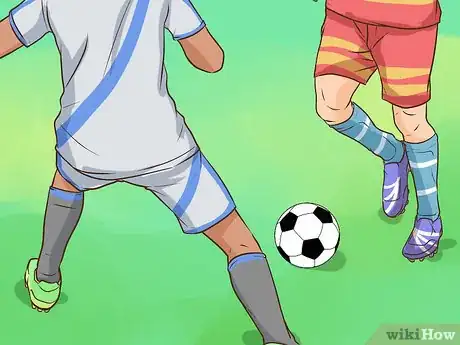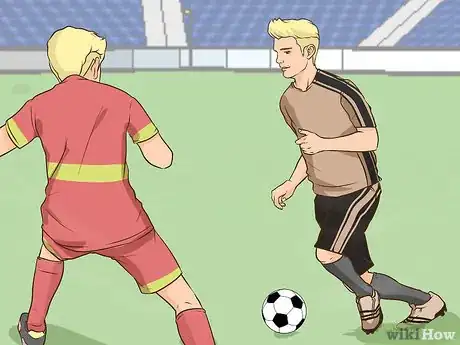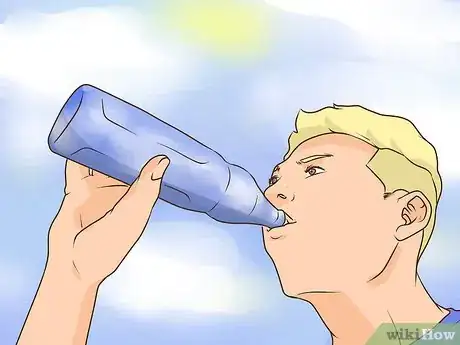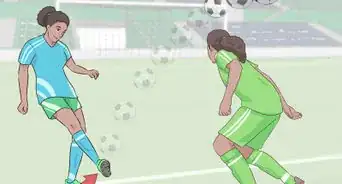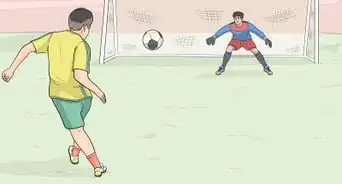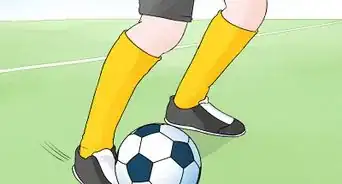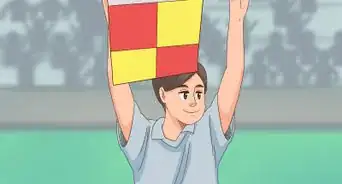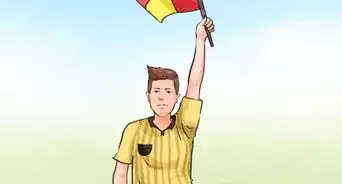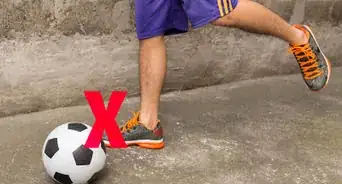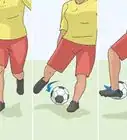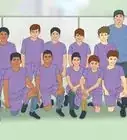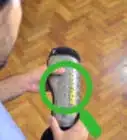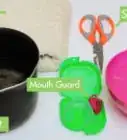This article was co-authored by Walter Merino. Walter Merino is a Youth Soccer Coach and Co-Founder of Ole Soccer Club based out of the Los Angeles, California area. He has coached youth from the age of four to the high school and college levels. Walter has played collegiate soccer for Cal Poly Pomona and Los Angeles Mission College. His accomplishments include coaching Olé Soccer Club to win the 2017 Cal South State Cup Governors Boys 2007 Division title.
There are 8 references cited in this article, which can be found at the bottom of the page.
This article has been viewed 41,486 times.
Whether you're a coach or a player, getting the most out of practice is the best way to get the most out of your games. Good soccer practices are focused, challenging, and technical. You don't want to just show up ahead of time; have a plan for improvement and the work ethic to make it a reality.
Steps
Planning an Effective Practice
-
1Focus on 1-2 skills or ideas each practice. This is especially important with younger kids, but even older players benefit from focused practices.[1] Don't try and teach individual defending, corner kick plays, shooting, and two new drills on the same day. Instead, plan ahead of time to focus on one or two specific areas, allowing players to really concentrate on improving these areas. Some areas of practice naturally work well together, as well:
- Crossing and aerial work (headers, clearances, marking in the box, etc.)
- One on one defending and shooting.
- Short passes and off-the-ball movement.
- Close foot-skills and combination play (overlaps, one-two passes, etc.)
-
2Start practice with a mobile, dynamic warm up. Static stretching, the classic "bend and hold," can actually cause more problems than it prevents.[2] Today's coaches use dynamic stretching, which gets the body moving and prepares your players with more game-like motions and movements. To make an effective dynamic warm-up, have the players:
- Jog for 5-10 minutes, often with a ball at their feet.
- Switching every 20 yards (18.3 m) or so, do lunges, high knees, butt kickers, side-shuffles, jumping jacks, and skips.
- Do 2-3 accelerating sprints, where they start at a jog and then work to top speed.
- Lightly stretch any sore muscles.
Advertisement -
3Aim for 500 touches per player in each practice. Obviously, you aren't going to count. The more important concept is that players should be on the ball as much as possible in practice.[3] While there are plenty of uses for ball-less drills -- teaching positioning, discussing tactics, working on plays -- almost every drill can be made more efficient if the players are getting touches on the ball as well.[4]
- Be aware of drills where only 1-2 players touch the ball. Can you incorporate passing, break the drill into smaller groups, or find another way to get the ball on player's feet?
- High-intensity ball drills, such as passing drills, dribbling activities, or even partnered crossing, are a great way to start practice with a focus on technique.
-
4Teach a technique, then reinforce it with drills and game-like situations.[5] If you're focusing on how to curve crosses, for example, you don't just want to teach it and move on. Start with a demonstration about how to curve the ball, then let the kids start trying it in pairs. From there, reinforce the skill through drills or scenarios. For example, you might do a crossing drill where players must take a touch down the line, then hit a cross to an attacker in the box. Finding 2-3 ways to teach and practice the skill is the best way to nail it down.
-
5Keep the whole team engaged as much as possible. Avoid activities where most players are standing in line, or where one group of players sit and watch for long periods of time. As much as possible, keep kids active and moving. If you do have drills that require some standing around, there are ways to use the time effectively:
- When players are in line, have them pair up and pass while waiting. They must keep their head up as the pass so they don't miss their turn in line, which is another valuable skill.
- Instead of sitting a group out during scrimmages or drills, separate them out on the end lines as "wings" that the offensive team can pass to, teaching good wide, expansive play.
-
6Tailor scrimmages to the skills you worked on in practice. For example, say you worked on crosses and headers in the first half of practice. To drive the point home, you might play a scrimmage where aerial goals count for two points, or that a team must hit at least one long cross before they are allowed to score. If you're working on smart passing and triangles, don't play a full-field scrimmage -- keep the area small to make dribbling impossible.
- Scrimmages are not "free play" time, they are the time to practice the skills learned in practice in a game-like setting.
- In general, smaller scrimmages (3v3, 4v4, etc.) are best for fitness and ball skills, whereas larger scrimmages help focus on tactics, off-ball movement, and positioning.[6]
-
7Praise hustle and hard work just as much as technical ability. Practice is the time to get better, not to show off what players already know. You want to create an atmosphere where players are willing to make mistakes, as long as they are working hard to fix them. For example, a player may hit five bad crosses in a row with their left foot because they are right-footed. Don't yell at them, which teaches them to just use their stronger right foot. Let them make the mistakes now and praise them for working on weaknesses.
- In general, the best way to get a lazier player to work hard isn't to yell at them, but to praise the players that are challenging themselves. The other players will often follow suit to earn your attention.[7]
-
8Correct techniques and mistakes as you see them. If you see a player trying to hit a cross and they always swing their legs across their body without turning their hips, don't just sit and watch even if they hit a good cross occasionally. You want to be positive but proactive to make your players the best they can be. When correcting bad behavior or technique, use the "sandwich method" of a compliment, then advice, then another compliment:
- "I love how hard you're working, but I need you to focus on squaring your hips when shooting. You've got a really good shot, this will just make it more accurate."[8]
-
9Try to make conditioning more than just running or sprints. Conditioning is a necessary part of training, but that doesn't mean players will like it. The more you engage kids, the harder they will work, so finding conditioning that isn't only punishment or grueling sprints can actually help your team get stronger faster. Some ideas include:
- Getting conditioning through scrimmages: make the field bigger with fewer players to force more movement, make the team that got scored on sprint back to their goal before starting, or run 1-2 minute "burst games" where the losing team must do push-ups.
- Have the player's pair up and pass back and forth while jogging or, if you have enough balls, have every player dribble as they run.
- Do push-ups and sit-ups with the team, showing it's not just punishment, it's a good way for everyone to get stronger.[9]
Practicing Well as a Player
-
1Eat a light meal 1-2 hours before starting. You need energy to have a good soccer practice. Avoid cheese or dairy, as well as greasy, fatty, and overly sugary foods and drinks. Instead, look for simple carbohydrates, like white bread, pasta, or rice, and some lean proteins like chicken, peanut butter, tuna, or turkey slices.
- PB & Js, light spaghetti bowls, pretzels and hummus, or a turkey sandwich are all good options.
- Wash this meal down with 1-2 tall glasses of water and keep drinking as practice approaches.
-
2Set training goals. The first step to getting better at something is to know what you want to get better at. Setting training goals lets you get the most out of drills, find and eliminate weak spots in your game, and challenge yourself to get better. Keep these goals specific -- instead of "be a better passer," decide to work on left foot passing, one touch passes, or hitting more accurate crosses.
- If you're struggling with one of your goals, talk to your coach for advice. Ask if he has any drills or techniques you can work on during practice to improve.
- Take control of your practices -- your coach is there to help you get better, but you'll be twice as good if you're proactive about your own play as well.
-
3Use warm-ups to target any soreness or tightness beyond the coach's warmup. While your coach likely has a good warm-up planned for you, you should still take care to your own unique needs. After doing the team warm up, gently stretch any areas you need to take care of on your own. When possible, use dynamic warm-ups, which keep you moving instead of just pulling and holding a stretch:
-
4Stay on your toes, in an active athletic position, whenever practicing. Being "on your toes" is the mantra of many coaches, and for good reason. Keeping your weight on the balls of your feet instead of your heels helps you spring into action on a moments notice. In a game, you should almost always be up on your feet, ready to run, pass, or jump, so build the habit in practice.
- Bend your knees slightly.
- Lean forward and inch or so.
- You should be able to instantly push off to either side. If you need to bend your knees or shift your weight first you're not on your toes.
-
5Develop skill with both feet. Players who are effective with both their right and left feet are incredibly dangerous on the field. Practice is the time to take your weak foot and turn it into a weapon. Whenever possible, try to alternate feet, and force yourself to take crosses, shots, and passes with your weak foot in scrimmages.[12]
- Remember that now is the time to make mistakes. The more you learn from errors now the less you'll cause in a game.
-
6Focus on individual defending in scrimmages and one-on-one drills. One on one defending, where you need to tackle or steal the ball from an attacker by yourself, is an essential skill no matter what position you play. Even strikers need to be able to challenge and defend against the other team's backs, as winning the ball back is the first step towards scoring. Some tips for individual defending include:
- Bend slightly at the hips, staying on the balls of your feet, to move quickly.
- Keep one foot forward, using this foot and you body to force them to go to one side of you. Push them towards the sideline or one of your teammates.
- Look at their belt-buckle area. Where a player's hips point generally tells you where they're about to go.
-
7Do every drill, game, or activity at game speed. The more you can treat practices like games, the better you will be when an actual whistle blows. Unless you have a game the next day and need to rest slightly, which your coach should note, you should be challenging yourself at every opportunity to play at game pace. Practice isn't about showing off, it is about getting better. This only happens if you push yourself.
- Challenge your teammates, especially on other teams. Some healthy competition makes everyone better.
- Don't shy away or hide weakness -- this is the time to improve them.
- You should be tired out after drills and practices, so don't try and save energy.
-
8Cool down with light stretching and a jog to prepare for the next practice. A good cool down helps your muscles relax and prevents soreness and injury the next day. Take a light jog, almost at walking pace, and shake out any tight muscles. This is a good place for gentle static stretching as well, so feel free to lightly grab and hold sore muscles for 10-20 seconds each.
- While you should always be drinking water, be sure to have a full glass after practice to replenish lost fluids. Dehydration is a big cause of later soreness.
- Get some food within an hour of practice to help fuel muscle regeneration and repair.
Expert Q&A
Did you know you can get expert answers for this article?
Unlock expert answers by supporting wikiHow
-
QuestionHow can I improve my soccer skills?
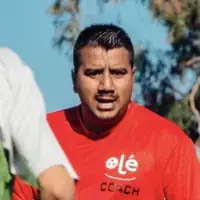 Walter MerinoWalter Merino is a Youth Soccer Coach and Co-Founder of Ole Soccer Club based out of the Los Angeles, California area. He has coached youth from the age of four to the high school and college levels. Walter has played collegiate soccer for Cal Poly Pomona and Los Angeles Mission College. His accomplishments include coaching Olé Soccer Club to win the 2017 Cal South State Cup Governors Boys 2007 Division title.
Walter MerinoWalter Merino is a Youth Soccer Coach and Co-Founder of Ole Soccer Club based out of the Los Angeles, California area. He has coached youth from the age of four to the high school and college levels. Walter has played collegiate soccer for Cal Poly Pomona and Los Angeles Mission College. His accomplishments include coaching Olé Soccer Club to win the 2017 Cal South State Cup Governors Boys 2007 Division title.
Soccer Coach Train multiple days a week. Practice dribbling, changing direction, and using right foot-left foot techniques. Really try to build a relationship with the soccer ball and gain an appreciation for the game. Also, play multiple positions in practice -- work on becoming a stronger overall player when possible to succeed wherever you are on the field.
Train multiple days a week. Practice dribbling, changing direction, and using right foot-left foot techniques. Really try to build a relationship with the soccer ball and gain an appreciation for the game. Also, play multiple positions in practice -- work on becoming a stronger overall player when possible to succeed wherever you are on the field. -
QuestionIf I'm sick and have a runny nose should I still go to soccer practice?
 Community AnswerNo, you should not. First, you'll lack energy and feel terrible and you might perform poorly and annoy other players trying to play with you. Second, you risk passing your illness onto other players and not a single one of them would thank you for that. Stay home, get fully well, then ease back into practice when you fell better again.
Community AnswerNo, you should not. First, you'll lack energy and feel terrible and you might perform poorly and annoy other players trying to play with you. Second, you risk passing your illness onto other players and not a single one of them would thank you for that. Stay home, get fully well, then ease back into practice when you fell better again. -
QuestionWhat should I do if my coach and teammates aren't supportive of my playing style?
 Community AnswerThat depends. Try to communicate with them to figure out what exactly they like and dislike about your playing style. Some of their complaints might be legitimate -- for example, you might not do a good job of passing the ball. Listen to their constructive criticism and consider whether your playing style could use some tweaking. If you disagree with them, then keep playing as you are.
Community AnswerThat depends. Try to communicate with them to figure out what exactly they like and dislike about your playing style. Some of their complaints might be legitimate -- for example, you might not do a good job of passing the ball. Listen to their constructive criticism and consider whether your playing style could use some tweaking. If you disagree with them, then keep playing as you are.
Warnings
- While you should always play at game speed, you generally want to hold up a bit on tackles, especially slide tackles. It doesn't help anyone to injure a teammate.⧼thumbs_response⧽
Things You'll Need
- Water
- Shin guards
- Athletic, breathable clothing
- Cleats
- Ball
- Cones
- Goals
References
- ↑ Walter Merino. Soccer Coach. Expert Interview. 29 January 2020.
- ↑ http://well.blogs.nytimes.com/2013/04/03/reasons-not-to-stretch/?_r=0
- ↑ Walter Merino. Soccer Coach. Expert Interview. 29 January 2020.
- ↑ http://soccerhelp.com/Soccer-Practice-Tips.shtml
- ↑ Walter Merino. Soccer Coach. Expert Interview. 29 January 2020.
- ↑ http://soccerhelp.com/soccer-articles/120903-Improve-Soccer-Team-2-Practices.shtml
- ↑ http://soccerhelp.com/Soccer-Practice-Tips.shtml
- ↑ https://www.linkedin.com/pulse/20130624125301-5670386-art-of-critical-feedback-making-a-criticism-sandwich
- ↑ http://www.active.com/soccer/articles/how-to-make-conditioning-worth-it-873767
- ↑ http://greatist.com/fitness/full-body-dynamic-warm-up
- ↑ http://www.momsteam.com/dynamic-stretching/dynamic-stretching-best-sports-warmup
- ↑ Walter Merino. Soccer Coach. Expert Interview. 29 January 2020.
